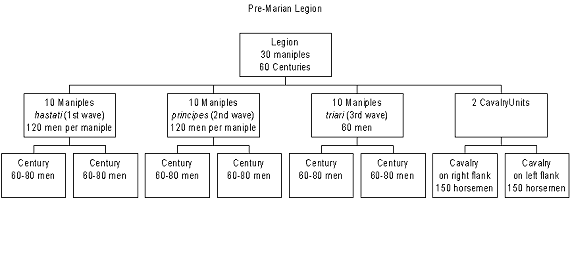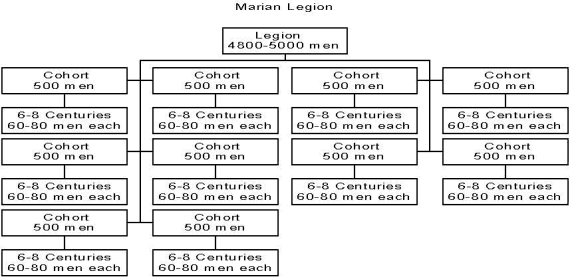Gaius Marius & The Reform of the Roman Legion
Rome's conquests were the offspring of the superiority of her
legions. And the superiority of her legions -- the premiere heavy infantry of the ancient and classical world --
was the result of the first century BC reforms of one man, Gaius Marius. The "Marian legion" was the instrument by which Rome rapidly
expanded and controlled its growing empire.
Marius� reforms were profound.
Rooted in the military needs of the Republic, they were made possible by
changes in the social and economic structure of the city not only in demographic
composition but by errors made by commanders using the old system. The upstart provincial who �had no Greek�
saved the city from crashing on the rock of hidebound tradition and lack of
foresight with a series of changes effecting every aspect of the army.
The army was changed from a militiasystem of citizen-soldiers drawn from the monied and propertied classes into a
professional force, with long term enlistments, composed of volunteers that
were paid for their service. Military training was emphasized and legionaries were put through rigorous and
continuous training. When not in the field, the men were tasked with a variety of engineering projects, such as road
building, that made them doubly useful to the states. Noncombatants were reduced from the army, streamlining its
efficiency and mobility. The soldiers, required to carry a sixty pound field pack on the march, called themselves �Marius� Mules� (Muli Mariani)
Aware of the psychological benefits of �small unit cohesion,� Marius introduced permanent unit
designations, histories and symbols for every level of the army from the eagles
of the legions to flags for smaller units.
The new Marian tactical system replaced the traditional manipular formation (based on the
phalanx) with a cohort-based design that created a fully articulated legion
design more capable of maneuvering and responding promptly to the orders of its
leaders.
A major redesign was made in the infantrythrowing spear or
pilum and the manner it was used. The alteration of the weapon and the
resulting new tactics created a battlefield environment in which the old design
problems were eliminated and the legions strength as a heavy infantry force was
enhanced.
Thanks to Marius, the military was now a truly professional institution, not merely tribal levies raised for particular emergencies.
Soldiers enlisted for specified periods, trained and drilled in standardized tactics and faced harsh discipline.
Marius created an army that campaigned methodically and persistently, in a thorough and unimpetuous manner.
It was this army that would go on to conquer an empire, that would last, in one form or another, for 1500 years.
But, as with all reforms, Marius� actions corrected one set of problems
only to give birth to another. The professionalization of the army led to greater
efficiency, a more effective fighting force and a series of unprecedented victories. But it also brought about the creation of an army, loyal to its commanders, that was to become a prime
force in Roman politics determining politicial events for centuries.
--David W. Tschanz


Adcocok, Frank. The Roman Art of War under the Republic (New York: Barnes
& Noble, 1960)
Brunt, PA. Italian Manpower 225 BC - AD 14.
Oxford: Oxford University Press, 1971.
Garlan, Y. War in the Ancent World.
New York: WW Norton, 1972
Livy. The War Against Hannibal.
Penguin Books, 1965
Plutarch. "Caius Marius" In The Fall of the Roman Republic. London:
Penguin Books, 1963.
Sallust. Jugurtha.London: Penguin Books, 1971
|